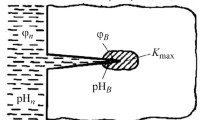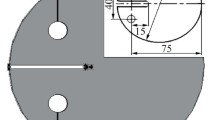We propose a method for the evaluation of the residual life of a spring plate of a truck containing a semielliptic crack under the action of cyclic loading and a hydrogen-containing medium. The method is based on the numerical model of fatigue crack propagation. This model is based on the energy criterion of fracture mechanics and takes into account the influence of an external hydrogen-containing medium. We compute the residual lives of hydrogenated and nonhydrogenated materials of the spring plate and compare the results accumulated in these cases.



Similar content being viewed by others
References
G. V. Karpenko, Strength of Steel in Corrosive Media [in Russian], Mashgiz, Moscow (1963).
V. R. Skal’s’kyi, “Acoustic-emission investigation of the sensitivity of spring steel to hydrogen degradation,” Fiz.-Khim. Mekh. Mater., 35, No. 4, 113–119 (1999); English translation: Mater. Sci., 35, No. 4, 572–580 (1999).
V. V. Panasyuk, Mechanics of the Quasibrittle Fracture of Materials [in Russian], Naukova Dumka, Kiev (1991).
O. E. Andreikiv, D. V. Rudavs’kyi, and O. V. Gembara, “Computational model of propagation of fatigue cracks in hydrogenated welded joints,” Fiz.-Khim. Mekh. Mater., 38, No. 6, 18–24 (2002); English translation: Mater. Sci., 38, No. 6, 780–788 (2002).
J. Morrow, “Investigation of plastic strain energy as a criterion for finite fatigue life,” in: The Garret Corporation Report, Phoenix, AR (1950), pp. 105–108.
B. A. Kolachev, Hydrogen Brittleness of Metals [in Russian], Metallurgiya, Moscow (1985).
V. V. Panasyuk (editor), Fracture Mechanics and Strength of Materials: A Handbook [in Russian], Vol. 1, Naukova Dumka, Kiev (1988).
A. E. Andreikiv and A. I. Darchuk, Fatigue Fracture and Durability of Structures [in Russian], Naukova Dumka, Kiev (1992).
M. P. Savruk, “Stress intensity factors in bodies with cracks,” in: V. V. Panasyuk (editor), Fracture Mechanics and Strength of Materials: A Handbook [in Russian], Vol. 2, Naukova Dumka, Kiev (1988).
N. S. Bakhvalov, N. P. Zhidkov, and G. M. Kobel’kov, Numerical Methods, Binom, Moscow (2001).
V. R. Skal’s’kyi and O. E. Andreikiv, Estimation of the Volume Damage to Materials by the Acoustic-Emission Method [in Ukrainian], Vyd. Lviv Nats. Univ., Lviv (2006).
Author information
Authors and Affiliations
Corresponding author
Additional information
Translated from Fizyko-Khimichna Mekhanika Materialiv, Vol. 49, No. 2, pp. 92–96, March–April, 2013.
Rights and permissions
About this article
Cite this article
Skal’s’kyi, V.R., Rudavs’kyi, D.V., Yarema, R.Y. et al. Residual Life of an Elastic Element of a Spring under the Action of Hydrogen-Mechanical Factors. Mater Sci 49, 237–242 (2013). https://doi.org/10.1007/s11003-013-9605-3
Received:
Published:
Issue Date:
DOI: https://doi.org/10.1007/s11003-013-9605-3




